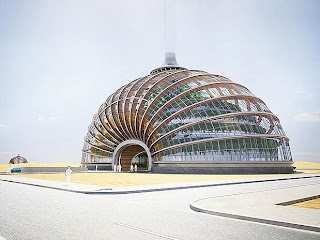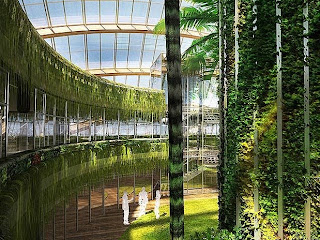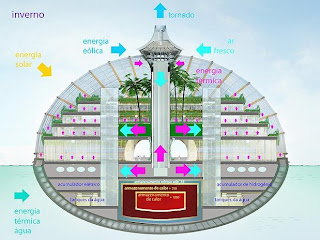Cortesia do blog p-rspectivas urbanas






For architecture two aspects are of higher concern: the first one is maintenance of security and precautions against extreme environmental conditions and climate changes. The second one – protection of natural environment from human activities. The Ark project makes an attempt to answer these challenges of our Time. The Ark project was designed on the basis of international experience received from the UIA Work Program “Architecture for Disasters Relief” and according to the concept of a bioclimatic house with independent life support sources. In such buildings provision is made for an independent life support system including elements ensuring a closed functioning cycle.


The structural solidity is provided by compression behavior of the timber arches and tension behavior of the steel ropes. The framework is covered by a special foil made of Ethyl TetraFluoroEthylene (ETFE). It is a strong highly transparent foil, self-cleaning, recyclable, more durable, more economical and lighter than glass. The foil itself is fixed to the framework by special metal profiles, which serve at the same time as solar collectors for water heating and as gutters intended for collecting rainwater from the roof surface.
It’s a cupola building with a central bearing in a form of a tube with all engineering communications passing inside it. Such a form permits to attain an optimum relationship between the building’s volume and its outer surface, which gives a substantial saving of materials and produces effective energy usage. Prefabricated frame permits to erect such buildings quickly.
The building makes a single energy system. The form of the cupola assists to create an air-eddy at the outer surface around the central bearing, where the wind power generator and tornado generator are placed. The form of the building is convenient for placing on it the photoelectric cells at a necessary angle to the Sun. The form of the cupola assists to agglomeration of the warmed air in the upper part. This heat is collected in seasonal heat accumulators, in electric and hydrogen accumulators, in order to provide an uninterrupted energy supply for the whole complex in spite of the outer environment conditions. The heat from surrounding environment – the outer air, water or ground – is also used. The building can produce extra power for supplying adjacent houses and “green” transport means.
The building makes a single energy system. The form of the cupola assists to create an air-eddy at the outer surface around the central bearing, where the wind power generator and tornado generator are placed. The form of the building is convenient for placing on it the photoelectric cells at a necessary angle to the Sun. The form of the cupola assists to agglomeration of the warmed air in the upper part. This heat is collected in seasonal heat accumulators, in electric and hydrogen accumulators, in order to provide an uninterrupted energy supply for the whole complex in spite of the outer environment conditions. The heat from surrounding environment – the outer air, water or ground – is also used. The building can produce extra power for supplying adjacent houses and “green” transport means.


The building could be constructed in different climatic zones and in seismically dangerous regions, because the structure of the basement represents a shell without any ledges or angles. A stressed structure of arches and ropes permits to distribute load along the whole bulk in case of earthquake.
The structure of the building permits it to float in case of water leveling up in the World Ocean, to keep afloat and exist autonomously on the surface of the water. All the wastes are utilized inside the building by methods of explosion boiling up and oxygen-free pyrolysis.
Planting of greenery – that’s the next step in creating a bioclimatic building. All the plants are chosen according to principles of compatibility, illumination and efficiency of oxygen producing, as well as with the aim of creating an attractive and comfort space. The triple height illuminated space permits to create well-lit places at any time of day. Through the transparent roof there is enough light penetrating for plants and for illuminating the inner rooms. The balconies serve as a way of communication and a recreation place. The building has free lay-out and might easily be adapted to different functions as the time goes.







